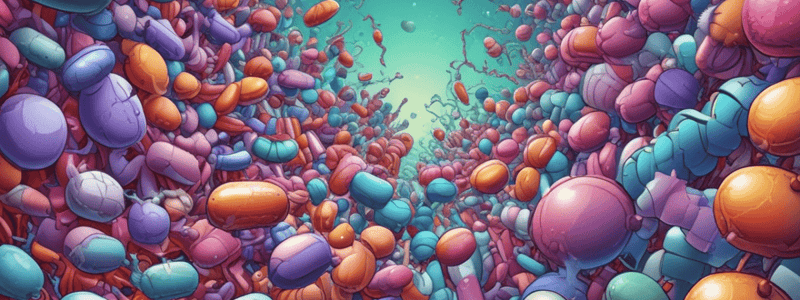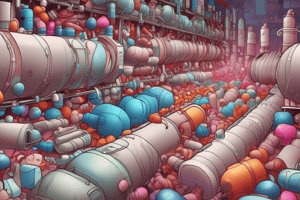Podcast
Questions and Answers
What is one of the mechanisms of aminoglycoside resistance that involves modification of the drug?
What is one of the mechanisms of aminoglycoside resistance that involves modification of the drug?
- Mutation of the bacterial ribosome
- Increased accumulation within the bacterium
- Presence of efflux pumps
- Bacterial enzymes such as acetyltransferases (correct)
What is the purpose of Neomycin* when given orally?
What is the purpose of Neomycin* when given orally?
- To treat bacterial infections in the gut
- To prevent bacterial infections in the skin
- For bowel decontamination (correct)
- To treat bacterial infections in the blood
Which of the following mechanisms of aminoglycoside resistance does not involve modification of the bacterium?
Which of the following mechanisms of aminoglycoside resistance does not involve modification of the bacterium?
- Decreased accumulation within the bacterium
- Mutation of the bacterial ribosome
- Bacterial enzymes such as acetyltransferases
- Presence of efflux pumps (correct)
What is the general term for the enzymes that modify aminoglycosides and prevent them from binding to ribosomes?
What is the general term for the enzymes that modify aminoglycosides and prevent them from binding to ribosomes?
What is the result of decreased accumulation within the bacterium?
What is the result of decreased accumulation within the bacterium?
What is the mechanism of aminoglycoside resistance that involves a change in the bacterial ribosome?
What is the mechanism of aminoglycoside resistance that involves a change in the bacterial ribosome?
What is the name of the aminoglycoside shown in Figure 6-2?
What is the name of the aminoglycoside shown in Figure 6-2?
Which of the following is NOT a mechanism of aminoglycoside resistance?
Which of the following is NOT a mechanism of aminoglycoside resistance?
What is the main mechanism of action of macrolides?
What is the main mechanism of action of macrolides?
How do macrolides function in a manner similar to aminoglycosides?
How do macrolides function in a manner similar to aminoglycosides?
What is the location of the macrolide binding site on the bacterial ribosome?
What is the location of the macrolide binding site on the bacterial ribosome?
What is the result of methylation of the ribosome binding site in some bacteria?
What is the result of methylation of the ribosome binding site in some bacteria?
What is the effect of the mef gene on macrolide accumulation in some gram-positive bacteria?
What is the effect of the mef gene on macrolide accumulation in some gram-positive bacteria?
What is a common mechanism of resistance to macrolides in some bacteria?
What is a common mechanism of resistance to macrolides in some bacteria?
What is the result of resistance to one member of the macrolide group?
What is the result of resistance to one member of the macrolide group?
What is the structural feature of macrolides that gives them their name?
What is the structural feature of macrolides that gives them their name?
What is the mechanism of action of efflux pumps in bacterial resistance to aminoglycosides?
What is the mechanism of action of efflux pumps in bacterial resistance to aminoglycosides?
Which of the following is a mechanism of bacterial resistance to aminoglycosides that involves changes to the ribosome?
Which of the following is a mechanism of bacterial resistance to aminoglycosides that involves changes to the ribosome?
What is the target of aminoglycoside binding in bacterial cells?
What is the target of aminoglycoside binding in bacterial cells?
Which of the following is NOT a mechanism of bacterial resistance to aminoglycosides?
Which of the following is NOT a mechanism of bacterial resistance to aminoglycosides?
What is the result of modification of the aminoglycoside in bacterial resistance?
What is the result of modification of the aminoglycoside in bacterial resistance?
Which mechanism of bacterial resistance to aminoglycosides involves the pumping of the antibiotic out of the cell?
Which mechanism of bacterial resistance to aminoglycosides involves the pumping of the antibiotic out of the cell?
What is the site of action of aminoglycosides in bacterial cells?
What is the site of action of aminoglycosides in bacterial cells?
Which of the following is a mechanism of bacterial resistance to aminoglycosides that does not involve changes to the antibiotic?
Which of the following is a mechanism of bacterial resistance to aminoglycosides that does not involve changes to the antibiotic?
Flashcards are hidden until you start studying
Study Notes
Macrolides
- Macrolides consist of a large cyclic core called a macrocyclic lactone ring, decorated with sugar residues.
- Macrolides bind tightly to the 50S subunit of the bacterial ribosome, blocking the exit of the newly synthesized peptide.
- They function similarly to aminoglycosides, targeting ribosomes and preventing protein production.
Mechanisms of Resistance
- Resistance to macrolides occurs by three mechanisms:
- Inhibition of drug entry and accumulation due to difficulty penetrating the outer membrane of aerobic gram-negative bacilli and active efflux pumps in some resistant bacteria.
- Enzyme-mediated ribosome binding site alteration, such as methylation, which prevents macrolide interaction.
- Mutation of the ribosome binding site, which rarely occurs.
Aminoglycosides
- Aminoglycosides are active against various bacteria, including gram-positive and gram-negative bacteria, as well as mycobacteria.
- Resistance to aminoglycosides occurs via three mechanisms:
- Efflux pumps prevent accumulation of the aminoglycoside in the cytosol of the bacterium.
- Modification of the aminoglycoside prevents binding to the ribosome.
- Mutations within the ribosome prevent aminoglycoside binding.
Antimicrobial Activity of Aminoglycosides
- Aminoglycosides are effective against:
- Gram-positive bacteria, including Staphylococci, Streptococci, Enterococci, and Listeria monocytogenes.
- Gram-negative bacteria, including Haemophilus influenzae, Enterobacteriaceae, and Pseudomonas aeruginosa.
- Mycobacteria, including Mycobacterium tuberculosis and Mycobacterium avium complex.
Studying That Suits You
Use AI to generate personalized quizzes and flashcards to suit your learning preferences.




